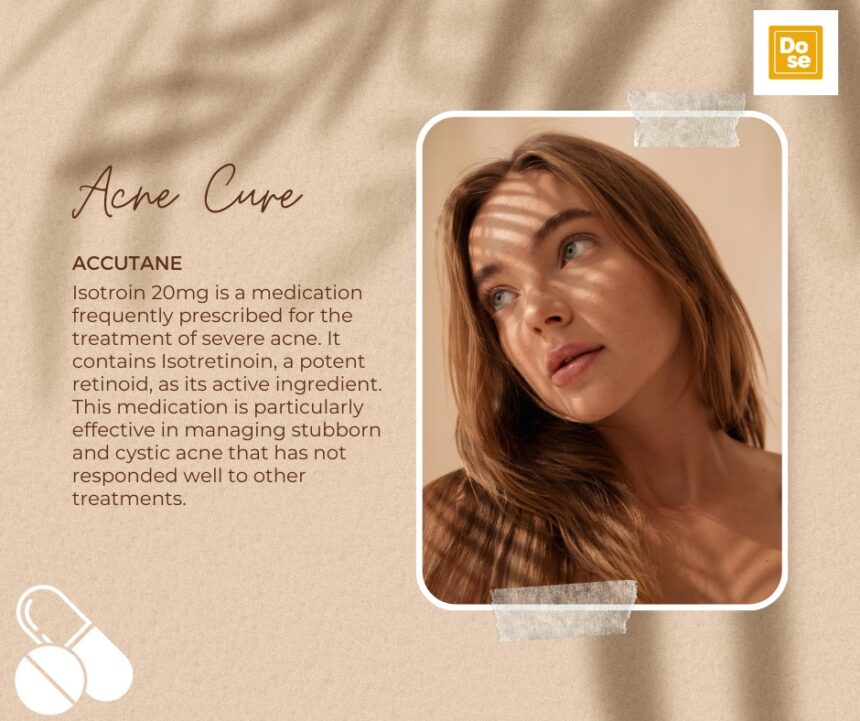Acne and breakouts are among the most common skin concerns worldwide, affecting people of all ages and skin types. While many of us associate acne with adolescence, it’s a condition that can persist well into adulthood. It not only affects one’s appearance but also has a significant emotional and psychological impact, causing low self-esteem and frustration. However, achieving clearer, more beautiful skin is possible with the right approach to treating active acne and preventing future breakouts.
In this blog post, we will explore how to treat active acne and breakouts effectively, focusing on skincare practices, lifestyle changes, and treatments with isotretinoin 20mg that promote the long-term health and beauty of your skin.
Understanding Active Acne
Before diving into treatments, it’s essential to understand what active acne is. Active acne refers to the phase when pimples, pustules, or cysts are present on the skin. These breakouts often result from clogged pores, excess oil (sebum), bacteria, and inflammation. Several factors, such as hormones, stress, diet, and improper skincare routines, can contribute to acne flare-ups. Knowing the root cause of your acne can help you find the most effective treatment.
Types of Active Acne
Active acne can manifest in several forms, and each type may require a different approach to treatment:
- Whiteheads and Blackheads: These are non-inflammatory types of acne, where clogged pores result in tiny bumps.
- Papules: These are small, red, inflamed bumps caused by bacterial infection within the pores.
- Pustules: These are similar to papules but filled with pus, making them more noticeable and often painful.
- Nodules and Cysts: These are severe forms of acne that occur deep beneath the skin’s surface, often resulting in painful, large lumps.
Steps to Treat Active Acne
1. Cleansing: The Foundation of Acne Treatment
The first step in treating active acne is keeping the skin clean. Use a gentle, sulfate-free cleanser that won’t strip your skin of its natural oils. Over-cleansing or using harsh products can irritate the skin, causing the skin to produce more oil, which exacerbates acne.
Look for cleansers with acne-fighting ingredients such as:
- Salicylic Acid: This beta hydroxy acid helps to exfoliate the skin and unclog pores, reducing blackheads and whiteheads.
- Benzoyl Peroxide: Effective in killing acne-causing bacteria, benzoyl peroxide is ideal for treating pustules and papules.
- Tea Tree Oil: Known for its natural antibacterial properties, tea tree oil can help reduce inflammation and fight bacteria.
Make sure to wash your face twice a day, once in the morning and once before bed, to remove excess oil and impurities.
2. Exfoliation: Unclogging the Pores
Exfoliation helps remove dead skin cells that clog pores and contribute to acne. However, it’s essential to choose the right exfoliator. Over-exfoliating can irritate the skin and make acne worse. Opt for chemical exfoliants such as:
- Glycolic Acid: An alpha hydroxy acid (AHA) that promotes cell turnover, helping to fade scar marks and prevent new breakouts.
- Lactic Acid: Another AHA that gently exfoliates the skin while hydrating it, making it ideal for sensitive or dry skin types.
Exfoliate no more than two to three times a week to avoid over-irritation.
3. Spot Treatments: Targeting Active Breakouts
Spot treatments are designed to target specific pimples or areas of breakout. These treatments often contain more potent concentrations of acne-fighting ingredients, such as:
- Benzoyl Peroxide: Works by reducing acne-causing bacteria and is highly effective for inflamed pimples.
- Sulfur: Helps dry out the surface of the skin and absorb excess oil, making it effective for pustules and papules.
- Tea Tree Oil: A natural alternative for those with sensitive skin or who prefer plant-based remedies.
Apply spot treatments directly to the affected areas after cleansing and moisturizing your skin.
4. Moisturizing: Maintaining the Skin Barrier
It’s a common misconception that acne-prone skin doesn’t need moisture. In reality, skipping moisturizer can make pimple worse. When the skin is stripped of moisture, it produces more oil to compensate, which can clog pores.
Choose an oil-free, non-comedogenic moisturizer that won’t clog pores. Look for hydrating ingredients like:
- Hyaluronic Acid: Hydrates the skin without adding excess oil.
- Niacinamide: A form of vitamin B3 that reduces inflammation, regulates oil production, and strengthens the skin barrier.
Apply moisturizer after cleansing and using any treatments to maintain healthy, hydrated skin.
5. Sun Protection: Preventing Acne Scars
Sunscreen is crucial, especially when treating acne. Many acne treatments, such as retinoids or chemical exfoliants, make the skin more sensitive to the sun. Without protection, the skin is more prone to developing scars and hyperpigmentation.
Opt for a broad-spectrum sunscreen with an SPF of at least 30 that is oil-free and non-comedogenic. Mineral-based sunscreens containing zinc oxide or titanium dioxide are great options for sensitive, acne-prone skin.
Long-Term Strategies for Preventing Future Breakouts
1. Diet and Nutrition
What you put into your body can significantly impact your skin. While everyone’s skin reacts differently to food, some common dietary factors can trigger breakouts, such as:
- High Glycemic Foods: Foods that cause a rapid spike in blood sugar, such as white bread, sugary snacks, and processed foods, can increase inflammation and oil production.
- Dairy: Some studies suggest that dairy products, particularly milk, can exacerbate acne in some people due to hormones and bioactive molecules.
Incorporate a diet rich in fruits, vegetables, whole grains, and lean proteins. Foods high in antioxidants, such as berries, spinach, and green tea, can help reduce inflammation and support skin health.
2. Manage Stress Levels
Stress is a significant contributor to pimple. When stressed, your body produces more cortisol, a hormone that increases oil production and inflammation, leading to breakouts. To combat stress, consider:
- Exercise: Regular physical activity helps reduce stress and improve circulation, delivering more oxygen and nutrients to the skin.
- Meditation: Mindfulness practices, such as meditation or yoga, can help reduce stress and improve overall well-being.
Incorporating these practices into your routine can help prevent stress-induced breakouts.
3. Adequate Sleep
Lack of sleep can cause increased inflammation and stress hormone production, worsening pimple. Aim for 7-9 hours of quality sleep each night to allow your skin to heal and regenerate.
When to See a Dermatologist
If over-the-counter treatments and lifestyle changes aren’t improving your acne, it might be time to see a dermatologist. They can prescribe stronger medications accutane 40 mg or treatments such as:
- Topical or oral retinoids: Help reduce oil production and promote skin cell turnover.
- Antibiotics: Reduce bacteria and inflammation.
- Hormonal treatments: For those with hormone-related acne, such as women with polycystic ovary syndrome (PCOS).
A dermatologist can also provide professional treatments such as chemical peels, laser therapy, or extractions for more severe cases of acne.
Conclusion
Treating active acne and breakouts requires a consistent skincare routine, lifestyle changes, and patience. By understanding your skin type, using the right products, and adopting healthy habits, you can achieve clearer, healthier, and more beautiful skin. Remember, treating acne is not a one-size-fits-all approach. It may take some trial and error to find what works best for your skin. Stay persistent, and consult a dermatologist if necessary to get the best treatment plan tailored to your needs.






